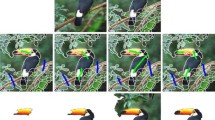Abstract
The general object recognition method is based on the various area segmentation algorithm. With these methods, segmentation is not very difficult if the boundaries between objects are clear, but if the boundaries are vague, the segmentation of the adjacent objects becomes inaccurate. So in order to solve this problem, we propose an efficient method of dividing adjacent circular-shape objects into single object. For segmentation into single object, the final segmentation object is determined in the following three steps: detection of the ROI, determination of the candidate segmentation points, and creation of a segmentation boundary. As a result, robust performance of average 6.2 % difference compared to the existing methods were derived in the experiments, even with severe SNR case.




Similar content being viewed by others
References
Catmull E, Rom R (1974) A class of local interpolating splines. In: Barnhill RE, Reisenfeld RF (eds) Computer aided geometric design. Academic Press, New York, pp 317–326
Chande B, Dutta Majumder D (1988) A note on the use of gray level co-occurrence matrix in threshold selection. Sig Process 15(2):149–167
Comaniciu D, Meer P (1997) Mean shift analysis and application. Seventh Int’I Conf. Computer Vision and Pattern Recognition pp.750–755
Kang C-C, Wang W-J (2007) A novel edge detection method based on the maximizing objective function. Pattern Recognit 40(2):609–618
Kang DJ, Kweon IS (1999) A fast and stable snake algorithm for medical images. Pattern Recognit Lett 20(10):1069
Kass M, Witkin A (2004) Demetri terzopoulos active contour models. Int J Comput Vis 1:321–331
Li W, Zhou C, Zhang Z (2004) Segmentation of the body of the tongue based on the improved snake algorithm in traditional Chinese medicine of the 5th World Congress on Intelligent Control and Automation. pp. 15–19
Muerle JL, Allen DC (1968) Experimental evaluation of a technique for automatic segmentation of objects in complex scenes. IPPR, Thopmson
Murphy TM, Math M, Finke LH (2003) Curvature covariation as a factor of perceptual salience. International IEEE EMBS CNECI, pp. 16–19
Najman L, Schmitt M (1994) Watershed of a continuous function. Sig Process (Spec Issue Math Morphol) 38:99–112
Ng EYK, Chen Y (2006) Segmentation of the breast thermogram: improved boundary detection with the modified snake algorithm. J Mech Med Biol 6(2):123–136
Norio B, Norihiko I, Toshiyuki T Image area extraction of biological objects from a thin section image by statistical texture analysis. Electron Microse 45:298–306
Otsu N (1979) A threshold selection method from gray level histogram. IEEE TSMC 9(1):62–66
Rother C, Kolmogorov V, Blake A (2004) GrabCut: interactive foreground extraction using iterated graph cuts. ACM Trans Graph 23(3):309–314
Unser M (1995) Texture classification and segmentation for using wavelet frames. 4(11):1549–1560
Yan P (2008) Automatic segmentation of high-throughput RNAi fluorescent cellular images. IEEE Trans 12(1):109–117
Zabih R, Kolmogorov V (2004) Spatially coherent clustering using graph cuts. Computer Vision and Pattern Recognition, IEEE Computer Society Conference 2:437–444
Acknowledgments
This research was supported by MSIP (the Ministry of Science, ICT and Future Planning), Korea, under the IT-CRSP(IT Convergence Research Support Program) (NIPA-2013-H0401-13-1001) supervised by the NIPA(National IT Industry Promotion Agency).
Author information
Authors and Affiliations
Corresponding author
Rights and permissions
About this article
Cite this article
Eun, SJ., Whangbo, TK. Efficient circular-shape object segmentation method for adjacent objects. Multimed Tools Appl 74, 8951–8959 (2015). https://doi.org/10.1007/s11042-013-1695-2
Published:
Issue Date:
DOI: https://doi.org/10.1007/s11042-013-1695-2




